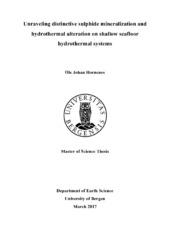Unraveling distinctive sulphide mineralization and hydrothermal alteration on shallow seafloor hydrothermal systems
Master thesis
Permanent lenke
https://hdl.handle.net/1956/15749Utgivelsesdato
2017-04-22Metadata
Vis full innførselSamlinger
- Department of Earth Science [1050]
Sammendrag
Since the discovery of seafloor hydrothermal systems in the late 1970´s, they have been found in different types of geological settings. Recent discoveries of active, inactive and inferred vent fields on the Arctic Mid Ocean Ridge reveals that hydrothermal activity might be more common than previously assumed. The Artic Mid Ocean ridge is a slow to ultra-slow spreading ridge, which can sustain long-lived hydrothermal activity with the potential to form large polymetallic mineral deposits. There is a growing interest in exploitation of seafloor hydrothermal deposits, as global demand for metal resources is growing. Exploration for these seafloor massive sulphide deposits is therefore an opportunity for academic research, and discovering metal resources of economic value. This thesis focuses on Perle and Bruse vent fields located on the southern segment of Mohn´s ridge and Aegir Vent Field located on central Mohns ridge. Perle and Bruse are part of the Jan Mayen Vent Fields, which also includes Troll wall and Soria Moria. Jan Mayen Vent Fields were discovered in 2005 during the BIODEEP-05 cruise. Perle and Bruse were later discovered in 2013 during the CGB cruise, and explored and sampled during the 2014 CGB cruise. Aegir Vent Field was discovered during the 2013 CGB cruise, and explored and sampled during the 2015 NORMAR/CGB cruise, and 2016 CGB cruise. Polished thin sections from the sampled material, was studied in transmitted and reflective light followed by Scanning Elecron Microscope using EDS to understand the petrography and mineralogy. Samples were powdered for isotopic analyses of Strontium, sulphur, radiometric dating of barite and whole rock geochemistry. Active chimney material from Perle is dominated by anhydrite, while barite is found in sampled mound rubble. Active chimneys from Bruse are dominated by barite, and have relict crystals of anhydrite that are partly dissolved. Both Vent fields are dominated by the sulphides pyrite, chalcopyrite, sphalerite and minor amounts of galena. Bruse has higher amounts of silica and the sulphide covellite, which is reworked from chalcopyrite. Radiometric dating shows that samples from Perle (7,4±0,4) is younger than Bruse (1400±50). Aegir shows a range of mineralogical assemblages that seems to be caused by age differences. The material is dominated by anhydrite, which seems to dissolves as the chimneys grow older, getting more enriched in barite, silica and sulphides. The sulphide phases are dominated pyrite, sphalerite, chalcopyrite and galena. Sr isotopes shows a degree of mixing between the hydrothermal fluid and seawater endmembers, Perle and Bruse shows an isotopic ratio closer to the hydrothermal fluid end member than Aegir which is closer to seawater values. Perle and Bruse have sulphur isotopes with values close to seawater.
